 1870
1870 1886
1886


WWI begins June 28.
Ends November 11, 1918.

Buttons made from freshwater mussels peak at 5.7 billion buttons. The inside of their shells have a prized iridescence.
 1920
1920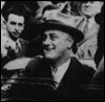 1932
1932
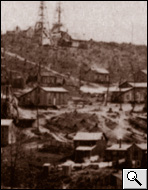
150 timber rafts run out of Red Bank Creek on a spring flood; 2,500,000 feet of boards and 600 feet of square timber damaged in flood waters.
First brick street in the world was laid in Charleston, West Virginia.

Johnstown region sends over 225,000 pounds of chestnuts to Pittsburgh markets. The American Chestnut was a dominant hardwood species in western PA forests until 1950, when the chestnut blight removed it from eastern forests.
Unmentionable Rivers Debate, over the 45th Congress Public Works Bill is a lively discussion about the Kiskiminetas-Conemaugh Rivers, that underlines the difficulty representatives from western PA had in getting public monies appropriated for their part of the state.
Southern New York and northern Pennsylvania at center of hemlock tanbark and leather industry. Hemlock bark is used to cure leather used in everything from shoes, clothes, saddles, harnesses, seat coverings, and belting for the nation's factories. Tannins extracted from the bark of hemlock acted on the proteins in hides to produce strong, flexible, resistant leather.

Near the town of Mt. Jewett, the Kinzua Railroad Viaduct which crosses the Kinzua Creek Valley is completed. The bridge stands 301 feet above the ground and is 2,053 feet long. Once the highest and longest bridge in the world, it remains the longest.

40 percent of the original forest remaining in the Allegheny Watershed.
Intensive timbering leaves vast areas of virgin white pine forest in Clarion River region nearly depleted.

Johnstown Flood. South Fork Dam gives way May 31, at 3:10 p.m.; 2,209 people killed. Above, the Schultz House pierced through by a large tree.
February flood on Allegheny measured at Pittsburgh: 300,000 cubic feet/second (cfs). Minimum volume to date measured at Pittsburgh: 950 cfs. People used to walk or take their horses to cross the river when it was this low.
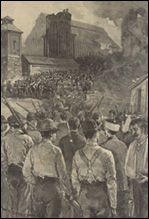
Pinkertons arrive at Homestead Steel Works to break July 6 steelworker's strike for better wages and working conditions.
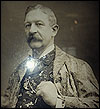 "Rattlesnake"
Pete Gruber sits for a portrait wearing his suit made out of rattlesnake
skins. His museum in Oil City, attached to his dad's bar, had many unique
contents. All were lost in the flood and fire of 1892.
"Rattlesnake"
Pete Gruber sits for a portrait wearing his suit made out of rattlesnake
skins. His museum in Oil City, attached to his dad's bar, had many unique
contents. All were lost in the flood and fire of 1892. Over 140,000 acres of forest (almost 220 square miles) are cut per year in PA for underground coal mine props alone.
 Kaul
and Hall Mill at Saint Mary's is typical of cutting operations in the
late 19th century.
Kaul
and Hall Mill at Saint Mary's is typical of cutting operations in the
late 19th century. Pennsylvania accounts for over 60 percent of the value of all products of the wood distillation industry. Early industrial solvents, like methanol, were derived from wood.
Extracted from Jefferson County: a record 7,123,118 tons of coal; 40 million feet of lumber (25 million of which is white oak). Considered the last run of white oak.

Log rafts on Allegheny floated down from forested regions to the north like the Clarion or Redbank watersheds. Above, sternwheeler passes log rafts, steel mills in background.
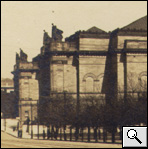
Funded by steel magnate Andrew Carnegie, the Carnegie Institute opens, displaying the world's first extensive dinosaur collection.
Pennsylvania's Purity of Waters Act prohibits raw sewage discharge into rivers and excludes acid mine drainage and tannery discharges.
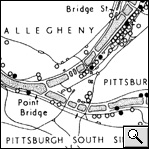
62 iron and steel works are located along the Allegheny River, 58 on the Monongahela. Allegheny County was producing more iron and steel than the remainder of PA. With the use of Lake Superior ores and the adoption of new manufacturing processes, Pittsburgh was "the industrial center of the greatest iron and steel manufacturing region in the world".

March 15, 35.5' flood at Pittsburgh.
1907

Rachel Carson, biologist and author of Silent Spring, is born May
27, Springdale, PA.
1907
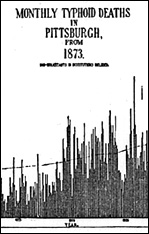 In
Pittsburgh, there are 70 deaths in June due to typhoid fever: the highest
number of deaths in one month due to typhoid since records began in 1873.
Sand filters are introduced at Public Water Works in Pittsburgh that same
year. From then on, incidents
of typhoid rapidly decline.
In
Pittsburgh, there are 70 deaths in June due to typhoid fever: the highest
number of deaths in one month due to typhoid since records began in 1873.
Sand filters are introduced at Public Water Works in Pittsburgh that same
year. From then on, incidents
of typhoid rapidly decline.
1907

December 6, Monongah,
West Virginia, was the site of the worst mine disaster in the history
of the United States.
Ortmann Report published "...the Allegheny [at Pittsburgh] is utterly polluted, and we have here possibly the greatest variety of pollution of any of the streams in the state."
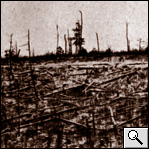
Fire ravages forest landscape of Kinzua Valley. Hills and mountains were denuded by early clearcut timbering operations. Clearcuts were further affected by fires starting from sparks emitted from wood-burning locomotives. The decimation of forests in the upper Allegheny Watershed contributed significantly to flooding in towns and cities far downstream.
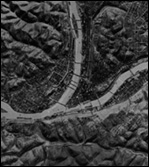
Pittsburgh Flood Commission Report published. Four years in the making, the Report, presided over by H.J. Heinz, establishes a blueprint for the construction of 17 flood control dams and reservoirs in both Allegheny and Monongahela basins. Clay model from report shown above.
Since 1806, rivers at Pittsburgh have crossed the 22-foot stage 78 times; 30-foot stage, 15 times.

.06 percent of the original forest remaining in the Allegheny Watershed.

First baseball radio broadcast August 5 on KDKA in Pittsburgh: Pirates v. Phillies.
West Virgina became first state to have a sales tax.

Allegheny National Forest established; 512,000 acres to act as "sponge" for storm events. Because of trees' abilities to absorb and handle water, it was recommended in the 1912 Flood Commision Report to establish large, protected, forested areas to absorb precipitation from heavy rain events and snow melts.

Commonwealth of PA takes ownership of 7,219 acres of Cook Forest.
Mrs. Minnie Buckingham Harper was appointed to the West Virginia House of Delegates, becoming the first African American woman to become a member of a legislative body in the United States.

Western Pennsylvania Conservancy founded with the intent to acquire and protect rare natural areas.

March 16-18 Pittsburgh experienced its highest flood in history. Called the St. Patrick's Day Flood the waters crested at 46 feet. The Triangle was inundated, power and telephone lines were down. Industrial fires raged; flood waters were polluted with raw sewage and industrial chemicals. 100,000 people lost their homes, 3,000 people were injured, some died.